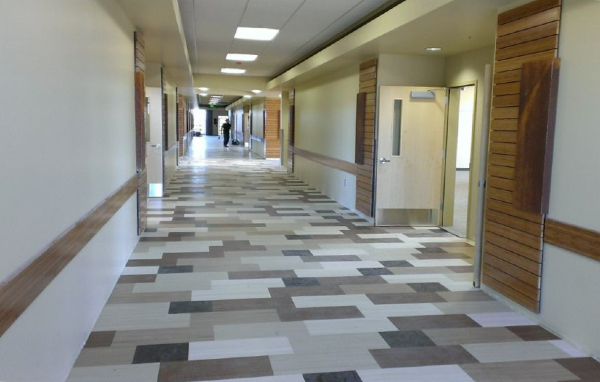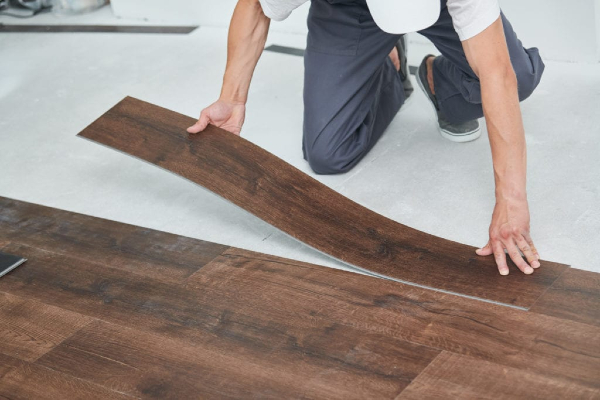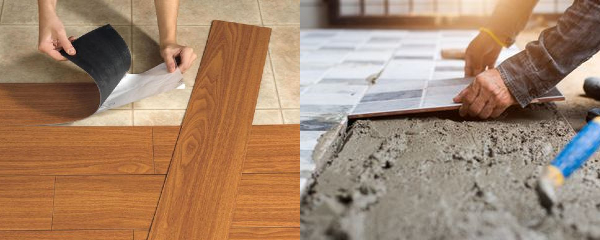What Is Vinyl Flooring And Some Of Its Advantages?
Vinyl flooring is a type of synthetic floor covering made from plastic or polyvinyl chloride (also known as PVC).
Unlike the thin PVC mats found in some traditional kampung houses, modern vinyl floorings come with multiple layers, making it gentle on the feet compared to standing on ceramic tiles for extended periods of time.
When it comes to designs and textures, homeowners have a huge variety to choose from, including styles that mimic hardwood floors, rough stone finish, and ceramic tiles.
In our country, vinyl tiles designed for floors that carry a wooden theme are popular alternatives to timber flooring or parquet tiles.
Not only does it elevate the look of a home at a more affordable cost, but it requires little maintenance and is not susceptible to termite attacks!
What Are Some Disadvantages Of Vinyl Flooring?
Compared to ceramic or marble tiles, vinyl flooring can get damaged pretty easily from dragging sharp and/or heavy objects across the floor.
It is also labour intensive to remove if glued down, which can damage the subfloor, and potentially have an impact on the resale value of a home.
While installation might seem easy, improper preparation of the subfloor, and uneven installation leads to faster wear and tear over time.
Since vinyl flooring is made from PVC – a petrochemical product derived from petroleum, a finite resource – the entire lifecycle of the product (from manufacturing to the end-of-life stage) is unsustainable, polluting, and environmentally damaging.
Vinyl flooring and the type of adhesive used also poses the risk of emitting volatile organic compounds (VOCs) in the home.
These chemicals are released via a process called ‘off-gassing’ which can lead to adverse health effects like frequent headaches, nausea, dizziness, and long-term breathing complications.
Thankfully, the flooring industry is producing more low- or zero-VOC vinyl floors that can be installed without adhesives.
An easy tip is to look out for brands that offer non-toxic vinyl products that are low-VOC certified. Another way to identify low-VOC products is to see if you can sniff it out!
Much like how that ‘new car smell’ is attributed to off-gassing, vinyl flooring will have a bit of a smell to it, which is normal, and should wear off in time. However, the smell shouldn’t make you feel ill.
Different Types Of Vinyl Flooring For Different Needs
1) Sheet vinyl (approximately RM3 per sq ft, excluding installation)
Flexible sheets, or sheet vinyl, come in large rolls that are cut precisely to fit the entire floor area.
Since it is cut and installed in one big piece, sheet vinyl is great for use in areas with high moisture like the kitchen and bathroom.
It minimises the chance of water seeping through the individual pieces of vinyl to the subfloor and damaging it.
However, avoid using sheet vinyl in the shower area where excessive moisture can build up and damage the vinyl or subfloor, especially if the vinyl punctures.
Sheet vinyl is also anti-slip, easy to clean, and provides acoustic insulation against stomping feet (both children and childish adults).
2) Vinyl composite tile (approximately RM3.70 per sq ft, excluding installation)
Vinyl composite tiles (VCT) come as thick (roughly 3mm) waterproof square or rectangular tiles. It is made by compressing PVC chips with a limestone mix, to create a flexible but thick and durable product.
VCT is designed to withstand high traffic and is frequently used in commercial areas like hospitals and education centres.
For comfort and long-lasting durability, especially in areas like the kitchen, VCT is a durable and affordable option to help minimise pressure underfoot and makes cleaning up a breeze.
3) Luxury vinyl tiles or planks (approximately RM4.50 per sq ft, excluding installation)
Luxury vinyl tiles (LVT) have slowly been gaining traction among Malaysians because it looks more natural, while being waterproof and termite-proof.
LVT come as square tiles or rectangular planks. Having an even floor is key, as LVT planks can be installed and interlocked, without needing to glue them down. This is also known as a floating floor.
Made up of several layers, the bottom layers provide protection against moisture, gives it the desired thickness, and prevents shrinkage.
A print layer with designs goes on top of it, giving it an extremely realistic wood, marble, or stone effect.
The print layer is then protected by two additional layers – a wear layer and a UV layer – to prevent the floor from being scratched or scuffed from the movement of furniture legs or cabinets.
Those with kids or pets will benefit from vinyl floor tiles being used in the bedroom, hall, and kids playroom – or any areas of the house where spills and accidents tend to occur.
You know how kids can be like when they’re excited! So, in the event of serious damage, replacing individual tiles is a lot easier compared to redoing the entire floor.
Pros And Cons Of Vinyl Flooring
If you’re deciding on whether to refresh your home with some new flooring, here is a simplified list to help you decide if vinyl floors are for you:
|
Pros
|
Cons
|
|
Soft underfoot (prevent aching feet)
|
Can be punctured or damaged by sharp and/or heavy objects
|
|
Waterproof, stain-resistant
|
Quality can vary even from the same manufacturer
|
|
Easy installation and maintenance
|
Labour intensive and time consuming to remove once glued down
|
|
Can withstand heavy foot traffic
|
No impact, or potentially even negative impact, on home resale value
|
|
Durable
|
Improper installation leads to bulging and faster wear over time
|
|
Cost effective
|
Not eco-friendly throughout the manufacturing process, product lifecycle, and end-of-life stage
|
|
Noise absorption
|
Potential to emit volatile organic compounds (VOCs)
|
|
Lots of design options
|
Discolouration over time
|
With all that time spent at home over the last year, it might be a good idea to give your home a new look, using the floor as your canvas.
Don’t stop there though. You can even consider applying textured vinyl sheets or tiles to your walls and ceiling for some reallyyy cool effects!
Relevant Guides:
Disclaimer: The information is provided for general information only. PropertyGuru International (Malaysia) Sdn Bhd makes no representations or warranties in relation to the information, including but not limited to any representation or warranty as to the fitness for any particular purpose of the information to the fullest extent permitted by law. While every effort has been made to ensure that the information provided in this article is accurate, reliable, and complete as of the time of writing, the information provided in this article should not be relied upon to make any financial, investment, real estate or legal decisions. Additionally, the information should not substitute advice from a trained professional who can take into account your personal facts and circumstances, and we accept no liability if you use the information to form decisions.







